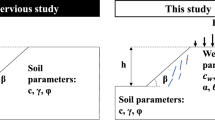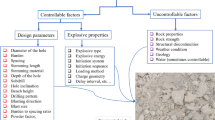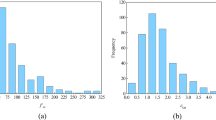Abstract
Cutter life is an important economical index for tunnel boring machines (TBM) excavation, and its prediction is widely concerned. This paper introduces a method for predicting cutter life on the basis of statistics and regression. Traditional researches only evaluate the average mileage or time interval of each cutter change. Differently, the proposed method can accurately predict the mileage position of each cutter relatively, on the premise of knowing the installment radius of each cutter and the rock properties along the tunnel. In this procedure, the influence of the rock classification and rock properties of each cutter passing area on their passing distance is obtained by linear regression. For proposing and verifying the prediction method, totally 1,200 records of cutter changing caused by normal cutter wear are collected from the 4th Section of Water Supply Project from Songhua River. Among them, randomly selected 920 samples are used to determine the regression coefficients involved in the method. The method is verified by the rest 280 samples, and a reliable predicted result is obtained (MAPE = 27%, and R2 = 0.69).
Similar content being viewed by others
References
Barton N (2000) TBM tunnelling in jointed and faulted rock. Balkema, Rotterdam, Netherlands
Benato A, Oreste P (2015) Prediction of penetration per revolution in TBM tunneling as a function of intact rock and rock mass characteristics. International Journal of Rock Mechanics & Mining Sciences 74:119127, DOI: https://doi.org/10.1016/j.ijrmms.2014.12.007
Bieniawski ZT, Celada CB, Galera JM, Tardaguila IG (2009) Prediction of cutter wear using RME. Proceedings of ITA-AITES world tunnel congress 2009 & 35th ITA general assembly, May 23–28, Budapest, Hungary
Bruland A (1998) Hard rock tunnel boring. PhD Thesis, Norwegian University of Science and Technology, Trondheim, Norway
Choi SO, Lee SJ (2015) Three-dimensional numerical analysis of the rock-cutting behavior of a disc cutter using particle flow code. KSCE Journal of Civil Engineering 19(5):1129–1138, DOI: https://doi.org/10.1007/s12205-013-06224
Choi SO, Lee SJ (2016) Numerical study to estimate the cutting power on a disc cutter in jointed rock mass. KSCE Journal of Civil Engineering 20(1):440–451, DOI: https://doi.org/10.1007/s12205-015-2265-0
Dahl F, Grøv E, Breivik T (2007) Development of a new direct test method for estimating cutter life, based on the Sievers’ J miniature drill test. Tunnelling and Underground Space Technology 22(1):106–116, DOI: https://doi.org/10.1016/j.tust.2006.03.001
Du LJ, Ji SS, Zuo LF, Kong HX, Xu JL, Du YL (2015) Wear and consumption of large diameter disc cutters for hard rock TBM under giant porphyritic granite. Journal of China Coal Society 40(12): 2974–2978, DOI: https://doi.org/10.13225/j.cnki.jccs.2015.3042
Ewendt G (1992) Erfassung der gesteinsabrasivitat und prognose des werkzeugverschleißes beim maschinellen tunnelvortrieb mit diskenmeißeln. Kurzberichte aus der Bauforschung 33(9): 821–822 (in German)
Frenzel C (2011) Disc cutter wear phenomenology and their implications on disc cutter consumption for TBM. 45th American rock mechanics/ geomechanics symposium, June 26–29, San Francisco, CA, USA
Frenzel C, Käsling H, Thuro K (2008) Factors influencing disc cutter wear. Geomechanik und Tunnelbau 1(1): 55–60, DOI: https://doi.org/10.1002/geot.200800006
Gehring K (1995) Prognosis of advance rates and wear for underground mechanized excavations. Felsbau 13(6):439–448 (in German)
Hamidi JK, Shahriar K, Rezai B, Rostami J (2010) Performance prediction of hard rock TBM using Rock Mass Rating (RMR) system. Tunnelling and Underground Space Technology 25:333–345, DOI: https://doi.org/10.1016/j.tust.2010.01.008
Hassanpour J (2018) Development of an empirical model to estimate disc cutter wear for sedimentary and low to medium grade metamorphic rocks. Tunnelling and Underground Space Technology 75:90–99, DOI: https://doi.org/10.1016/j.tust.2018.02.009
Hassanpour J, Rostami J, Azali ST, Zhao J (2014) Introduction of an empirical TBM cutter wear prediction model for pyroclastic and mafic igneous rocks; A case history of Karaj water conveyance tunnel Iran. Tunnelling and Underground Space Technology 43:222–231, DOI: https://doi.org/10.1016/j.tust.2014.05.007
Li SC, Liu B, Ren YX, Yang SL, Chen YK, Wang YH, Jiang P (2020a) Deep learning inversion of seismic data. IEEE Transactions on Geoscience and Remote Sensing 58(3):2135–2149, DOI: https://doi.org/10.1109/TGRS.2019.2953473
Li LP, Sun SQ, Wang J, Song SG, Fang ZD, Zhang MG (2020b) Development of compound EPB shield model test system for studying the water inrushes in karst regions. Tunnelling and Underground Space Technology 101:103404, DOI: https://doi.org/10.1016/j.tust.2020.103404
Ling JX, Sun W, Huo JZ, Guo L (2015) Study of TBM cutterhead fatigue crack propagation life based on multi-degree of freedom coupling system dynamics. Computers & Industrial Engineering 83: 1–14, DOI: https://doi.org/10.1016/j.cie.2015.01.026
Liu B, Guo Q, Li SC, Liu BC, Ren YX, Pang YH, Guo X, Liu LB, Jiang P (2020) Deep learning inversion of electrical resistivity data. IEEE Transactions on Geoscience and Remote Sensing, 1–14, DOI: https://doi.org/10.1109/TGRS.2020.2969040
Liu QS, Liu JP, Pan YC, Kong XX, Hong KR (2017a) A case study of TBM performance prediction using a Chinese rock mass classification system — Hydropower Classification (HC) method. Tunnelling and Underground Space Technology 65:140–154, DOI: https://doi.org/10.1016/j.tust.2017.03.002
Liu QS, Liu JP, Pan YC, Zhang XP, Peng XX, Gong QM, Du LJ (2017b) A wear rule and cutter life prediction model of a 20-in. TBM cutter for granite: A case study of a water conveyance tunnel in China. Rock Mechanics and Rock Engineering 50(5):1303–1320, DOI: https://doi.org/10.1007/s00603-017-1176-4
Maidl B, Schmidz L, Ritz W, Herrenknecht M (2008) Hard rock tunnel boring machines. Wiley, New York, NY, USA
Matern N, Hjelmér A (1963) Forsøk med pågrus. Statens Väginstitut, Medelande nr. 65, Stockholm, Sweden
Nelson PP, Al-Jalil YA, Laughton C (1994) Tunnel boring project data bases and construction simulation. Geotechnical Engineering Report GR94–4, University of Texas at Austin, Austin, TX, USA
Preinl ZTBV (2006) Rock mass excavability indicator: New way to selecting the optimum tunnel construction method. Tunnelling and Underground Space Technology Incorporating Trenchless Technology Research 21(3):237–237, DOI: https://doi.org/10.1016/j.tust.2005.12.016
Rostami J (1997) Development of a force estimation model for rock fragmentation with disc cutters through theoretical modeling and physical measurement of crushed zone pressure. PhD Thesis, Colorado School of Mines, Golden, CO, USA
Selmer-Olsen R, Blindheim OT (1970) On the drillability of rock by percussive drilling. Proceedings of the 2nd congress of ISRM, September 21–26, Belgrade, Serbia
Sievers H (1950) Die bestimmung des bohrwiderstandes von gesteinen. Glückauf 86:776–784, DOI: https://doi.org/10.1007/BF00448777
Su PC, Wang WS, Huo JH, Li Z (2010) Optimal layout design of cutters on tunnel boring machine. Journal of Northeastern University (Natural Science) 31(6):877–881
Sun W, Ling JX, Huo JZ, Guo L, Song XG (2015) Study of TBM cutterhead fatigue damage mechanisms based on a segmented comprehensive failure criterion. Engineering Failure Analysis 58(1):64–82, DOI: https://doi.org/10.1016/j.engfailanal.2015.08.041
Tan Q, Yi L, Xia YM (2018) Performance prediction of TBM Disc cutting on marble rock under different load cases. KSCE Journal of Civil Engineering 22(4):1466–1472, DOI: https://doi.org/10.1007/s12205-017-1048-1
Wang LH, Kang YL, Cai ZX, Zhang Q, Zhao Y, Zhao HF, Su PC (2012) The energy method to predict disc cutter wear extent for hard rock TBMs. Tunnelling and Underground Space Technology Incorporating Trenchless Technology Research 28(3):183–191, DOI: https://doi.org/10.1016/j.tust.2011.11.001
Wen SZ, Huang P (2002) Tribology principle, second edition. Qinghua Publishing Company, Beijing, China
Wijk G (1992) A model of tunnel boring machine performance. Geotechnical Geological Engineeering 10:19–40, DOI: https://doi.org/10.1007/bf00881969
Zhou P, Guo JJ, Sun J, Zou DF (2019) Theoretical research and simulation analysis on the cutter spacing of double disc cutters breaking rock. KSCE Journal of Civil Engineering 23(6):3218–3227, DOI: https://doi.org/10.1007/s12205-019-1777-4
Acknowledgements
The authors would like to thank China Railway Tunnel Stock Company Limited and Jilin Province Water Resource and Hydropower Consultative Company of P.R. CHINA for sharing their experiences of data gathering efforts in the field. This research was supported by the National Program of the Key Basic Research Project of China (973 Program) (No. 2015CB058101), the National Natural Science Foundation of China (NSFC) (No. 51739007), the National Key Research and Development Program of China (No. 2016YFC0401805), the National Natural Science Foundation of China (NSFC) (No. U1806226), the Key Research and Development Program of Shandong Province (No. 2016ZDJS02A01).
Author information
Authors and Affiliations
Corresponding author
Rights and permissions
About this article
Cite this article
Wang, R., Wang, Y., Li, J. et al. A TBM Cutter Life Prediction Method Based on Rock Mass Classification. KSCE J Civ Eng 24, 2794–2807 (2020). https://doi.org/10.1007/s12205-020-1511-2
Received:
Accepted:
Published:
Issue Date:
DOI: https://doi.org/10.1007/s12205-020-1511-2




